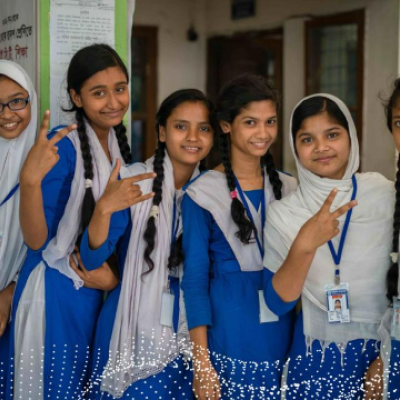In October 2015, the Council of the European Union endorsed the Gender Action Plan II for the period 2016-2020. The GAP II stresses the need for the realisation of women’s and girls’ full and equal enjoyment of all human rights and fundamental freedoms and the achievement of gender equality and the empowerment of women and girls.
A crucial part of achieving these objectives is fostering institutional capacities and inducing an institutional culture shift that is conducive to gender mainstreaming. To accomplish this, some staff at EU Delegations and DEVCO Units have been designated as Gender Focal Points, whose role is to provide momentum to the process.
|
What is the GAP? The GAP is the European Union’s framework for promoting gender equality and women and girls’ empowerment in external relations in third and partner countries, as well as in international fora and agendas. It is separate from, but fully in line with the Strategic Engagement for Gender Equality 2016 – 2019. The Later has five thematic priority areas of EU’s gender-equality policy, one of which is “promoting gender equality and women’s rights across the world” and refers specifically to the EU GAP. The GAP for 2016-2020 has four overall objectives: ensuring women’s and girl’s physical and psychological integrity; promoting women’s and girl’s social and economic rights; strengthening the voice and participation of women and girls; and shifting the institutional culture to ensure gender equality and women’s empowerment concerns are fully integrated in the EU’s external relations’ work. |
Two years into the implementation of GAP II, Capacity4dev spoke to Gender Focal Points at four EU Delegations to find out what the role means for them and about the specific challenges they face in shifting the institutional culture towards greater gender sensitivity.
Lessons learned
Much has been learned through the work done on the implementation of the Gender Action Plan for 2010-2015. The lessons, especially those related to the shortcomings, were fully taken on board with the new GAP II, said Blerina Vila, gender expert who supported DG DEVCO’s work on drafting the GAP and is currently involved with further technical assistance on its implementation.
The GAP II stipulates that by 2020, 85% of all new actions undertaken by the EU in partner countries must show a quantifiable contribution to gender equality, as indicated by the OECD Policy Gender Markers.
According to the report on the first year of GAP II’s implementation, the European Commission is still off achieving the target, but recent trends give cause for optimism, Vila said.
“There are many things we haven’t achieved yet when it comes to gender mainstreaming of all EU actions in external relations, but there has been faster progress compared to the previous years,” she said. “That’s thanks in no small part to the work of the Gender Focal Points. I’m optimistic that through the solutions they’re finding in their everyday work at EU Delegations and in Brussels, we will be able to progress even faster.”
To support the work of Gender Focal Points, special capacity-building efforts have been implemented, Vila said, including a regular global meeting, on-line and face-to-face training sessions, as well as direct support linked to gender mainstreaming in programmes and projects.
|
Blerina Vila on the lessons learned in the first two years of GAP 2016-2020: |
Commitment from everyone
The new GAP, Vila said, provides a common basis for the Commission services and the Member States in contributing to gender equality and women’s empowerment in partner countries. It is as much a guide, as it is a platform for coordination and synergies, to make sure that existing resources contribute to reaching the EU commitments.
A crucial part of achieving the objectives set by the GAP II is fostering institutional capacities and inducing an institutional culture shift that is conducive to gender mainstreaming.
Compared to the previous GAP, Vila said, the EU Delegations have been much more engaged with the issue. “We have Delegations that have taken steps towards shifting the institutional culture by conducting gender auditing of their programmes. We also have Delegations that have generated internal gender analysis that informs decision-making of their planning and programmes.”
|
What is gender mainstreaming? Gender mainstreaming is the integration of the gender perspective into every stage of policy processes – design, implementation, monitoring and evaluation – with the aim of promoting equality between women and men. It means assessing how policies impact on the life and position of both women and men – and taking responsibility to re-address them if necessary. For more information visit Capacity4dev’s Public Group on Gender |
While commending the role played by the Gender Focal Points, Vila said the commitment to gender mainstreaming must come from all levels, including the top management. “It’s clear that the Gender Focal Points’ role needs to be acknowledged by their respective teams and units,” she said. “In the last year, we’ve also realised how important it is to have a clear guidance from mid- and top-level management, not only in terms of the objectives, but also in supporting the staff in realising them.”
Vanessa de Sampaio e Melo, Gender Focal Point at the EU Delegation to the Democratic Republic of Congo, said that her current management is committed to achieving the GAP’s objectives.
“We’re very lucky to have a gender-conscious Delegation, starting with my colleagues all the way to the Head of Delegation,” she said. “If the hierarchy is not committed, it’s very difficult to get a place at a table to present and discuss gender issues.”
At her previous Delegation, de Sampaio e Melo managed to include gender-strengthening elements in her colleagues’ projects and programmes. “Staff at EU Delegations are already overloaded; they have a lot of tasks on their plate,” she said. “But if you take the extra step to show your colleagues how they could be addressing gender issues and give them some suggestions without imposing anything, they will integrate them. It’s a long process and it takes a little bit of informal networking, but, at the end of the day, I don’t think anyone will refuse to integrate elements that promote gender equality. They just need to know how to do it.”
|
Vanessa de Sampaio e Melo on the challenges of promoting gender-mainstreaming in DRC and on the importance of support from the Delegation’s management: |
Country priorities
Engaging local gender champions and NGOs can help, said Selma Cekic Dincsoy, Gender Focal Point at the EU Delegation to Kosovo. “At our Delegation, we’ve hired external experts who train us on how to implement the GAP and how to gender mainstream our programmes and action documents. These experts also assist people who work in the ministries.”
The experts come from the Kosovo Women Network. The partnership began in 2015 and has already produced strong results, said Dincsoy. “These are local experts who have tremendous experience in gender issues, and are very aware of the current laws and policies in the country. They also have a good relationship with the government – so they can best advise us on how to broach the issue.”
|
What does it mean to be a Gender Focal Point: |
|
The institutional culture shift According to Dincsoy, the key issue to greater gender sensitivity in any large organisation is the need for changing the organisational culture. “The institutional culture shift (ICS) should be practiced in every organisation and across all Member States,” she said. “The EU headquarters and the Delegations must all work together on promoting change and bringing in new mechanisms. The GAP is not just about superficial results, but about making real change in how we conduct our work.” What is ICS? For GAP II, the European Commission and the European External Action Service (EEAS) set aside six objectives for the institutional culture shift:
For more, read the Annual Implementation Report 2016 (PDF) |
One expert from the Kosovo Women Network has a permanent desk at the EU Delegation. “She’s kind of like our help desk,” Dincsoy said. “There is a small budget set aside for her, and she’s available any time we need expertise on gender. She also meets with the staff at the ministries to follow up on the documents we send there.”
As a Gender Focal Point, Dincsoy also has weekly meetings with Member States active in Kosovo. “We try to involve them as much as possible,” she said. “Fortunately, many – like Sweden and Austria – are actively involved on gender issues.”
|
Selma Cekic Dincsoy on working with the Kosovo Women Network: |
According to Dincsoy, the reason why some Member States are less committed to the GAP’s objectives is because they think of them as only applicable to EU projects and programmes. “What’s very important to understand is that the GAP is not just about the selected priorities, but also about shifting the existing institutional culture,” she explained. “And this applies to Member States just as much as the European Commission.”
Even when all Member States are on board, however, gender equality may not be the priority for the local government. When this is the case, the role of Gender Focal Points becomes much more difficult, said Ipek Seda Geçim Bakır, a temporary Gender Focal Point at the EU Delegation to Turkey “When I contacted the Turkish authorities and mentioned gender, their reply was, ‘This is not our priority,’” she said. “As GFPs, we need to change that kind of mind-set, to ensure that the local authorities are taking the issue seriously – but this is not always easy.”
|
Séverine Arnal on identifying indicators and using them to keep gender issues in dialogue with the governments (in French, with subtitles): |
A similar sentiment was expressed by Séverine Arnal, the Gender Focal Point at the EU Delegation to Burkina Faso. “The Member States in Burkina Faso are on board when it comes to achieving the GAP’s objectives,” she said. “Austria is collecting statistics that will serve as a great baseline for our indicators; Sweden funds women’s participation in the political sphere. You could say we’re all more motivated than the government.”
According to Arnal, the EU Delegation to Burkina Faso has done an extensive study to see how it could align its projects and programmes with the GAP’s objectives, while ensuring that the local ministries also implement gender-sensitive elements in their actions.
“We realise the needs are great,” Arnal said. “Gender inequality and sexual violence are issues that we all want to address. With the GAP, we have the tools; we can make an impact. The challenge is to ensure that our work is being followed up on the government level.”
Image credit: Silvio Balladares/EC/ECHO via Creative Commons license 2.0







Comments
Log in with your EU Login account to post or comment on the platform.